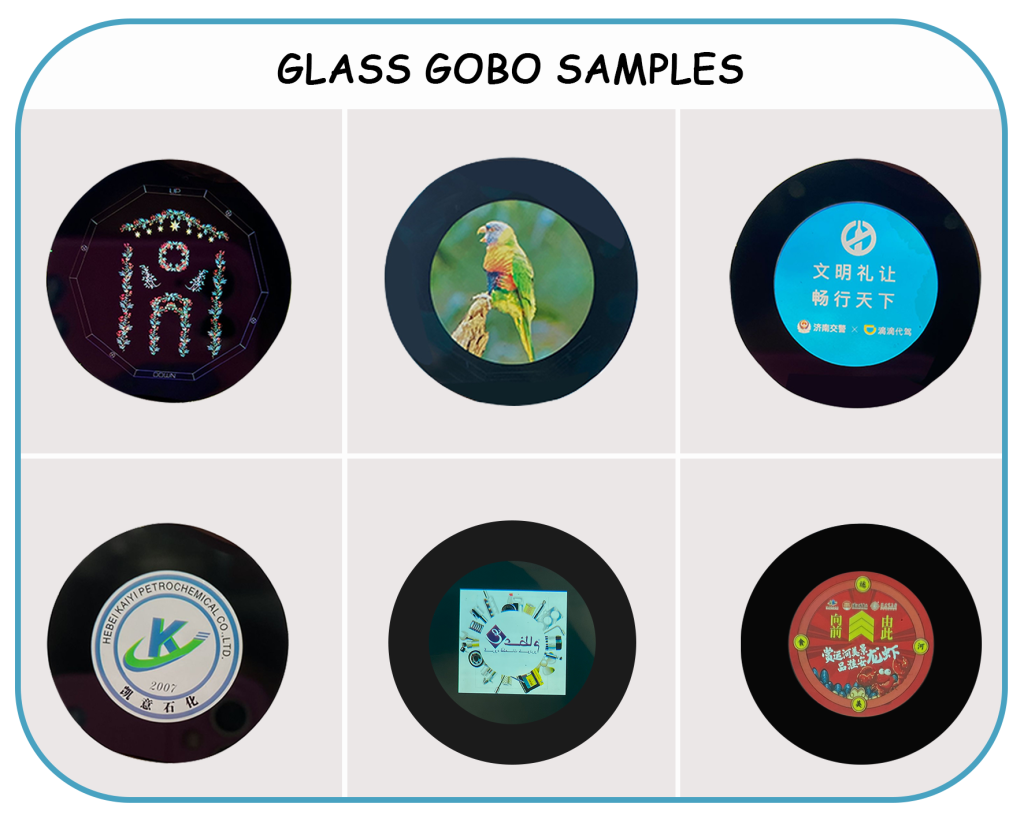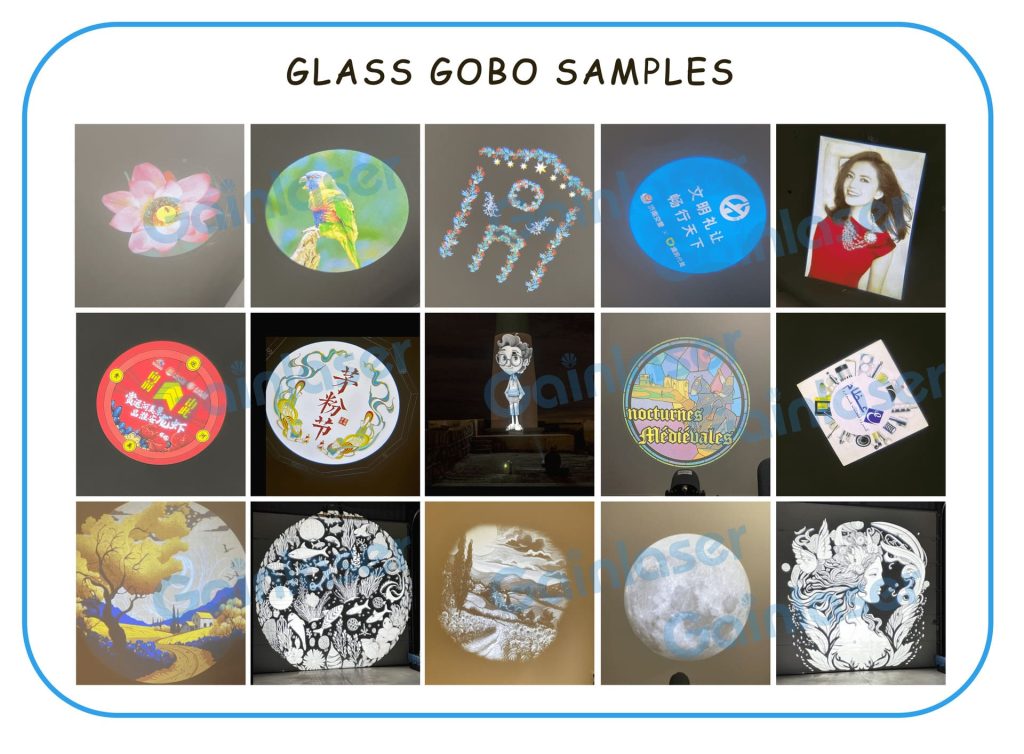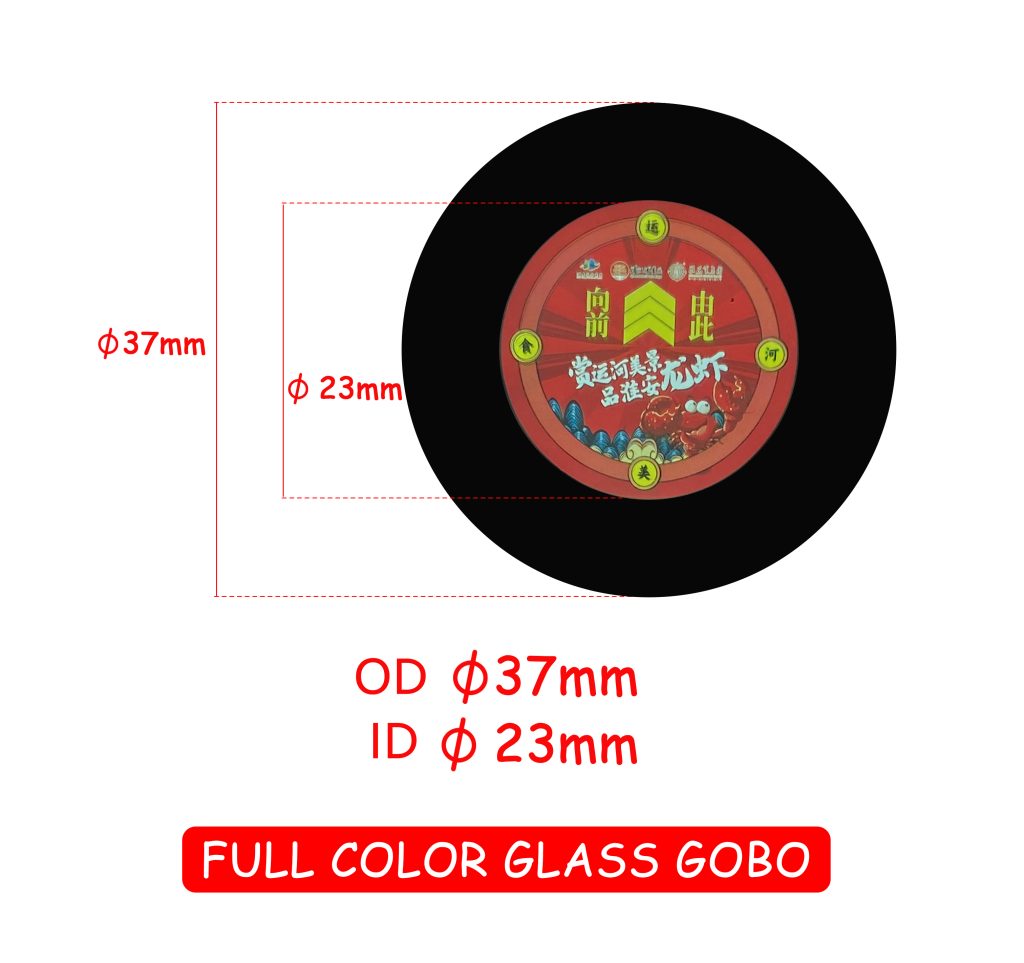Gobo has become a popular and versatile lighting equipment for almost any type of event, whether it is a wedding, birthday party, award ceremony, or corporate event.
Earlier, it was mostly used in formal settings for project company logos, brand names, and so on. However, almost everyone nowadays prefers to use this technique to project a special message, beautiful images, or patterns and make their event unique and memorable.
Among the various types of gobo, the full-color glass gobo is in high demand due to its versatile color options and high quality image projection. Read on to learn about different types of gobos, their unique features, and more.

Before we get into what a full-color gobo glass machine is, it is important to understand what a gobo is and what it is used for.
Gobo stands for “Go Between Optics”. It is a small circular disc that is placed between a light source and a projection screen to project various designs, images, and patterns that have been etched or cut out of the disc.
A Full-color Gobo Glass machine is a UV laser machine used to etch desired designs or patterns on a glass surface for projection. The full-color gobo consists of four colors, including CMYK (Cyan, Magenta, Yellow, and Black).
Four circular glass discs are used to create a single full-color glass gobo. Each disk is etched with individual colors and then aligned together after curing to produce a multicolor projection.
The two most common types of Gobos are metal Gobos and Glass Gobos. Besides, there is another type of Gobo, named Fim Gobo.

Let’s learn about these Gobos in detail:
A glass Gobo, also known as a full-color Gobo, is a kind of Gobo that is created by etching desired designs or patterns on the surface of the glass. The glasses that are used to produce the Gobo have high-temperature resistance. For this reason, it can be installed with high-intensity light sources without any risk of distorting or damaging the gobo.
The most intriguing feature of a glass gobo is its ability to project sharp images with multiple colors. The laser technology used to etch the glass surface creates designs that are identical to the original sample. As a result, when light passes through the gobo, the designs projected appear clear, crisp, and flawless.
The process of making a glass Gobo is somewhat complicated. The etching is created on four different glass surfaces, each of which contains either Black, Cyan, Magenta, or Yellow color. Later, all these pieces are attached together under a microscope to check the precision of the layering. Although it supports full color, it also allows for the projection of images in black and white and grayscale.
| Note: Glasses are delicate, so a Glass Gobo must be handled with care. |
A metal Gobo, also known as traditional Gobo, is a kind of Gobo that is made by creating cuts on thin metal (stainless steel or aluminum) sheets as per the provided sample design or pattern. The metal used for making these gobos is heat-resistant and durable. The metals are cut out using a laser, CNC machine, or chemical etching process.
Although production of these gobos is cost-effective, it has some limitations in creating fine details. Besides, they have color limitations. That is, only black & white or any single color filter can be used for the projection.
Despite being heat resistant, they cannot withstand the heat of the light when used for an extended period of time. As a result, they tend to warp and become distorted.
Film Gobo, also known as plastic gobo, is a temporary, low-budget alternative to glass or metal gobo. The desired pattern is printed on a heat resistant plastic film to create this type of gobo. Although they can produce satisfactory results, the image quality achieved is lower, and the gobos are less durable when compared to other gobos.
| Note: They are not compatible with a few projectors, as they can’t withstand excessive heat. |
Although a traditional gobo and a full-color gobo both play important roles in fulfilling the need for Gobo at various events, they have distinct characteristics and features that distinguish them from one another and serve different purposes.
The following are some unique features that make a full-color Gobo and a traditional Gobo different from one another.
A traditional glass Gobo and a full-color glass Gobo are both used to create designs, custom artwork, and logos. However, when it comes to creating intricate and complex designs, a full-color glass Gobo made of glass outperforms a traditional Gobo made of metal.
Creating Full-color glass Gobo involves using the highest-resolution laser beams. As a result, photorealistic projections are created that bring the designs to life. Moreover, complex designs can be recreated while maintaining their intricate details, be they geometric or abstract patterns.
On the contrary, traditional Gobos are mostly used to project company logos, texts, or simple designs that do not contain intricate details. As metal gobos are created by cutting off the design, fine details are hard to create.
Even if fine details are created, tabbing is a must to hold the design in place. So, it becomes more difficult to achieve the same level of precision in creating visually striking and dynamic displays as with a full-color glass gobo.
The manufacturing time of traditional Gobo and Full-color glass Gobo differs significantly. The production of traditional Gobo is conducted in a single layer. On the other hand, Full-color glass Gobos are created by etching multiple layers of glass with different color filters and aligning them precisely. So, naturally, full-color glass Gobo production takes more time compared to traditional Gobo.
Besides, metal Gobos necessitate tabbing (a thin line between letters or patterns to hold designs together), which occasionally alters the design; however, Full-color glass Gobos are produced exactly as the original design. Therefore, despite Full-color glass Gobo production taking longer manufacturing time, it is worth using as it doesn’t need adjustments like metal Gobo.
It may seem that metal Gobos are more durable than glass Gobos, but the reality is completely opposite. Metal Gobos are created by cutting off the materials. In the case of complex designs, tabbing is used to keep the whole design together. When a metal Gobo is placed in front of a hot fixture, it heats up and begins to warp. Consequently, the design gets distorted over time.
On the other hand, Full-color glass Gobos are created by etching glasses. For this reason, the structure of the Gobo remains intact, and there is no chance of it heating up and warping. Therefore, full-color glass Gobos are more reliable and durable compared to traditional metal Gobos.
Traditional metal Gobos have color limitations. Metal Gobo can project a single color or several shades of a single color. Usually, black and white designs are projected with metal Gobo, but if someone wants to project a single-color design, they have to use a color filter. The disadvantage of using a color filter is that multiple colors cannot be projected at the same time.
In contrast, full-color glass gobos offer unlimited color options. You can use it to project black and white, grayscale, and other colors of your choice. Apart from the infinite color option, the images are sharp and crisp compared to the traditional metal gobos.

When you are buying a Gobo machine from Gain Laser, you need to consider the following:
Gain Laser provides free installation instructions in the form of video tutorials for all of its products. These tutorial videos provide step-by-step instructions on installing the machine efficiently without causing any potential installation mistakes.
Customers can become familiar with the different components, features, and functions of the machine. This knowledge helps in understanding the machine’s operating process and connecting the equipment with one another.
These installation guides also include troubleshooting tips and solutions for common problems. Customers can follow those guidelines to resolve these issues without the need for service technicians or customer service. Consequently, these guidelines serve as a time and cost-saving solution.
Gain Laser assures fast delivery within 45 days for online shipping and 20 days for offline shipping after receiving the payment confirmation from both online and offline orders. However, customized machine delivery can take around 90 days.
The fastest delivery provides a lot of benefits to businesses. You can begin your projects earlier and meet deadlines. This will allow you to work on more projects and increase your revenue.
Gain Laser Provides one of the best customer support teams you will ever get from any company. Customer service representatives are available 24 hours a day, seven days a week. This means that you can get help from them, whether you have a problem during the holiday or at midnight. You can reach out to customer service in a variety of ways, including video calls, phone calls, and email.
The dedicated customer service team is specialized in their work. So, for any technical issues or general queries, they can guide you through proper guidelines so that you can encounter the challenges you encounter with your Full Color Gobo Glass Machine.
Gain Laser provides a 1-year warranty on every Full Color Gobo Glass Machine. That means, during the warranty period, the company will take responsibility for any machine flaws and will offer no-cost repairs or replacements for any damaged parts.
However, the warranty and service are only for manufacturing defects and malfunctions. If the machine or its components are damaged due to abuse, mishandling, or during shipment, the company won’t provide the warranty service. In this case, you can ask the company to make the repair at your expense.
You will need the following items to create a personalized Gobo display for your event.
A profile fixture, also known as a light fixture, is the light source in front of which the Gobo is installed or placed. Its sharp focus allows for crisp and clear image projection. Besides, it has an adjustable zooming feature that helps adjust the size of the projected image.
The Gobo holder is an accessory where the Gobo is placed and inserted within the profile fixture. This holder holds the Gobo in place, allowing light to pass through and project flawlessly. So, when selecting a Gobo, make sure that it fits perfectly within the Gobo holder.
Last but not least, you need a projection surface to display your Gobo image. Any flat surface—including a wall, a screen, a canvas, etc.—can be used as your projection surface.
Images such as a logo, text message, simple or complex patterns like geometrical shapes, abstract patterns, or photographs can be used in the full-color glass Gobo glass machine. However, to ensure the highest quality projected image with crisp, clear outlines, the images should be vector files in either ai or eps format.
Although both Glass Gobo and Steel Gobo are used in lighting fixtures to project images, they have significant differences, which are as follows:
Glass Gobo
Steel Gobo
The size of the Gobo is determined by the type of fixture in which it will be installed. However, the following measurements can be used as standard sizes for various projector light fixture sizes:

| Size | Outer Diameter | Inside Diameter/Image size |
| A | 100mm | 75mm |
| B | 86mm | 64.5mm |
| M | 66mm | 48mm |
| E | 37.5mm | 28mm |
The manufacturing time of a Gobo is determined by the type of material used and the design of the Gobo. Steel gobos can usually be manufactured and delivered within 1-2 business days. Full-color glass Gobos, on the other hand, are created with intricate details, and sometimes the designs are much more complex, so it may take 2-5 business days. However, if the manufacturing company receives an urgent request, delivery can be expedited.
Yes, whether your design is simple or complex, a full-color Gobo glass machine can create custom designs. Moreover, the machine provides a variety of color options, including black and white, grayscale, and other vibrant colors.
A full-color glass Gobo requires a lengthy production process. The process includes converting the image into a format suitable for the Gobo machine, printing the images on multiple layers of glass, and curing and assembling them in layers. So, depending on the complexity of the design, the standard time required to create a full-color glass Gobo is 3-5 working days.
So far, we have discussed the full-color gobo glass machine, different types of gobo and their differences, and other important details about the manufacturing process.
If you want to create high quality full-color glass Gobo, you should definitely try purchasing the full-color Gobo glass machine from Gain Laser. From high-quality machine service to high-quality customer service, your satisfaction is guaranteed.